Scottish Sea Fisheries Statistics 2019
National Statistics publication that provides data on the tonnage and value of all landings of sea fish and shellfish by Scottish vessels, all landings into Scotland, the rest of the UK and abroad, and the size and structure of the Scottish fishing fleet and employment on Scottish vessels.
3. Landings
3.1. Landings by Scottish vessels by species type
The one per cent decrease in the real terms value of landings by Scottish vessels to £582 million between 2018 and 2019 was driven by a decrease in the value of demersal and pelagic species. The real terms value of demersal landings decreased by seven per cent and pelagic landings decreased by five per cent compared to 2018, whereas shellfish landings increased 10 per cent.
The 12 per cent fall in tonnage landed by Scottish vessels is attributed to falls in landings of pelagic fish and demersal fish. Pelagic landings fell 18 per cent by tonnage and demersal landings fell 11 per cent. Shellfish landings increased 17 per cent.
| Tonnage 2019 |
Change from 2018 | Value (£000) 2019 |
Change from 2018 | |
|---|---|---|---|---|
| Demersal | 96,051 | -11% | 190,850 | -7% |
| Haddock | 27,199 | -6% | 41,285 | -4% |
| Cod | 14,549 | -21% | 40,797 | -8% |
| Monkfish | 10,701 | -16% | 34,178 | -13% |
| All other demersal | 43,603 | -8% | 74,589 | -4% |
| Pelagic | 234,457 | -18% | 195,228 | -5% |
| Mackerel | 127,628 | -16% | 158,128 | -5% |
| Herring | 49,433 | -24% | 26,049 | 5% |
| All other pelagic | 57,396 | -15% | 11,052 | -21% |
| Shellfish | 62,217 | 17% | 196,079 | 10% |
| Nephrops | 24,080 | 33% | 86,028 | 23% |
| Scallops | 15,019 | -2% | 35,728 | -11% |
| All other shellfish | 23,118 | 17% | 74,323 | 8% |
| Total | 392,726 | -12% | 582,158 | -1% |
As shown in Chart 2, in 2019 pelagic species represented 60 per cent by tonnage (234 thousand tonnes) and just over one third of value (£195 million). Demersal species represented nearly a quarter of the tonnage of all landings (96 thousand tonnes) and one third of the value (£191 million). Shellfish landings accounted for 16 per cent of tonnage (62 thousand tonnes) and 34 per cent by value (£196 million). This highlights the general difference in prices: Shellfish and demersal species generally tend to attract higher prices per tonne than pelagic species.
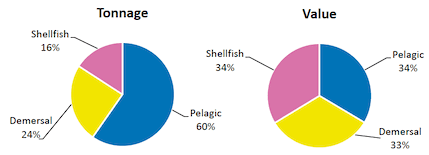
Pelagic species
Mackerel remained the most valuable species with £158 million, accounting for 27 per cent of the total value of Scottish landings. In 2019 the real value of mackerel landings fell five per cent and tonnage decreased by 16 per cent in line with a reduction in available quota. The real terms value of herring increased by five per cent and tonnage landed decreased 24 per cent since 2018.
Over the ten years 2010-2019, the tonnage of pelagic landings has increased by nearly one quarter (24 per cent) with real terms value rising by 29 per cent.
Demersal species
Scotland has a mixed demersal fishery which includes more than a dozen species with landings that are worth £1 million or more annually (Table 5). Most demersal species decreased in real terms value compared to 2018 with a modest increase in the value of saithe and whiting. The real terms value of wrasses increased 81 per cent. The top three demersal species by value are haddock, cod and monkfish (anglerfish). Haddock became the most valuable demersal species and represented seven per cent of the total value of Scottish vessels’ landings and 22 per cent of the value of demersal landings in 2019. Cod accounted for seven per cent of the value of Scottish vessels’ landings and 21 per cent of demersal landings in 2019. Monkfish accounted for six per cent of the total value of Scottish vessels’ landings and 18 per cent of the value of demersal landings in 2019.
Haddock landings fell in real terms value by four per cent but became the most valuable demersal species at just over £41 million. The real terms value of cod was down eight per cent to just under £41 million and monkfish fell 13 per cent to £34 million.
Compared to 2010, demersal landings fell nine per cent with real terms value increasing by seven per cent.
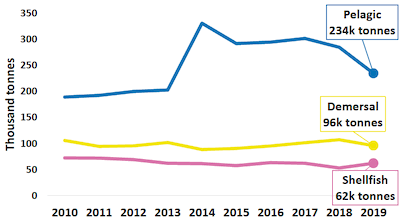
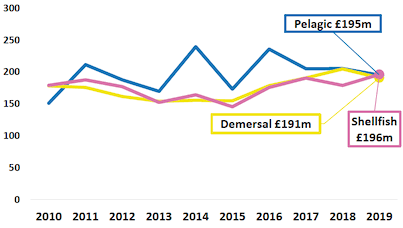
Shellfish species
Nephrops are the most valuable shellfish stock and the only shellfish species subject to quota. The Scottish fleet fish for Nephrops by creeling and by trawling. Creeled Nephrops are often caught and exported live. Creeled Nephrops typically represent a smaller tonnage of landings attracting a price per tonne more than three times that of trawled Nephrops. The average price per tonne of creeled Nephrops was £11,706 per tonne while for trawled Nephrops the average price was £3,081 per tonne. In 2019, 1,373 tonnes of creeled Nephrops were landed by the Scottish fleet with a value of £16 million[3]. 23 thousand tonnes of trawled Nephrops were landed worth £70 million[4]. These data are presented in Table 27.
Scallops contribute 6% to overall value landed by Scottish vessels, with £36 million worth being landed in 2019. Edible crabs, velvet swim crabs and lobsters make up a small proportion of overall value landed by Scottish vessels (eight per cent combined) but are important for Scotland’s large inshore fleet. Tonnage of edible crabs increased from 2018 by nine per cent to 11 thousand tonnes and the value in real terms decreased by two per cent to just under £25 million. Tonnage of lobsters increased by 2% from 2018 to 1,234 tonnes and the value in real terms remained consistent at £18 million.
Over the period 2010 to 2019, shellfish landings have fallen by 14 per cent while real terms value has risen nine per cent, reflecting growth in shellfish prices. This is in spite of the value of Nephrops falling by four per cent over the same period.
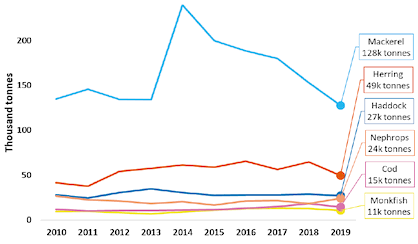
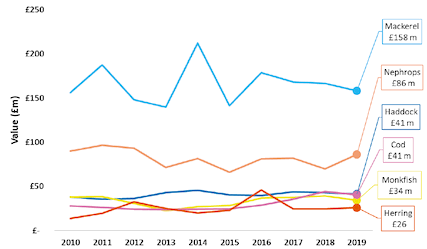
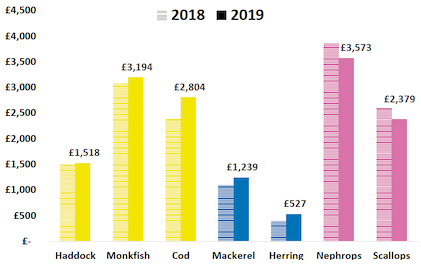
The price per tonne for each species is presented in Table 23 for the period 2015 to 2019.
3.2. Landings abroad by Scottish vessels
In 2019, Scottish vessels landed 148 thousand tonnes of sea fish and shellfish worth £124 million abroad. The tonnage landed abroad decreased by seven per cent and the real terms value of landings abroad remained consistent with 2018 (Table 4). Landings abroad accounted for 38 per cent of all landings by Scottish vessels by tonnage and 21 per cent by value. Of this, 95 per cent of the tonnage landed abroad was pelagic, three per cent was demersal and two per cent was shellfish.
The main species landed abroad was mackerel, representing 72 per cent of the total value of fish landed abroad in 2019. Since 2018, mackerel landings abroad have fallen in tonnage by eight per cent and increased in real terms value by two per cent. There were 71 thousand tonnes of mackerel worth £89 million landed abroad, which is 56 per cent of the total tonnage and 56 per cent the value of mackerel landed by Scottish vessels. The price for both mackerel landed into the UK and mackerel landed abroad in 2019 was an average of £1,239 per tonne.
Norway is by far the largest destination for Scottish vessels’ landings abroad, accounting for 51 per cent by tonnage and 65 per cent by value of all Scottish vessels’ landings abroad. Landings into Norway fell 19 per cent by tonnage compared to 2018 and the real terms value of these landings have fallen by seven per cent (Table 25). The fall in tonnage of mackerel landings into Norway is consistent with the fall in overall tonnage of landings of mackerel by Scottish vessels. Nearly all Scottish landings into Norway were of pelagic species.
In 2019, 86 per cent of the value of landings into Norway was for mackerel, amounting to 55 thousand tonnes with a value of £69 million.
Key countries for demersal landings were the Netherlands, Spain and Ireland. Scottish vessels landed five thousand tonnes of demersal species abroad with a value of £8 million.
There was 2,743 tonnes of shellfish landed abroad by Scottish vessels in 2019, an increase of 191% on 2018. These were mainly into Ireland, the Netherlands and France.
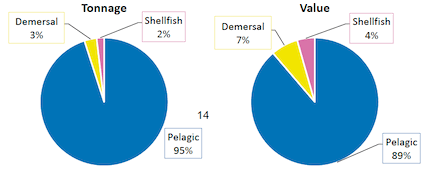
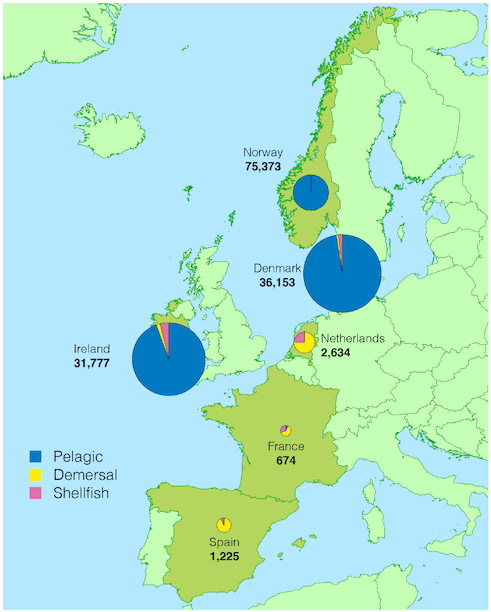
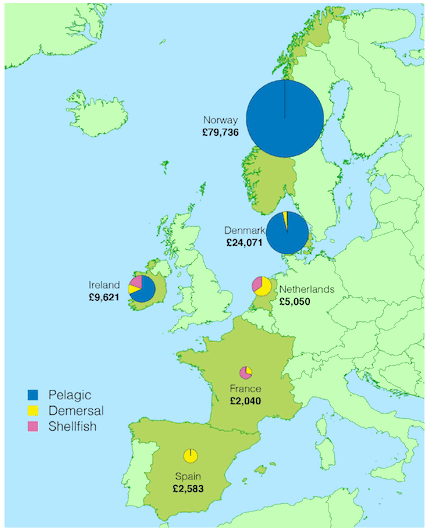
3.3. Landings by area of capture
Scottish vessels are most active in two main ICES Rectangles [5]: the Northern North Sea (ICES Area IVa) and the West Coast of Scotland (ICES Area VIa) (0 and 0). 220 thousand tonnes of sea fish and shellfish with a value of £328 million were landed from the Northern North Sea, representing 56 per cent of the tonnage and 56 per cent of the value of all landings by Scottish vessels (Table 28). Just over one fifth (22 per cent) of landings by Scottish vessels by tonnage were caught in the West Coast of Scotland (VIa), providing a little over one quarter (26 per cent) of the total value of all Scottish landings. Area VII (excluding the Irish Sea) accounted for 9 per cent of the tonnage of all landings and five per cent of value.
By species type, 68 per cent of the tonnage of all demersal landings by Scottish vessels was caught in the Northern North Sea (IVa), and 15% in the West Coast of Scotland (VIa). For pelagic landings, 58 per cent by tonnage were caught in the Northern North Sea (IVa) and 24 per cent were caught in the West Coast of Scotland (VIa).
Contrary to 2018, a higher tonnage of shellfish species was caught in the Northern North Sea than in the West of Scotland (Area Via). The Central North Sea (ICES Area IVb) and area VII (excluding the Irish Sea)) are also areas of considerable activity for shellfish fisheries. By tonnage, shellfish catches from the Northern North Sea (IVa) accounted for 32 per cent of all shellfish landings and 28 per cent of shellfish landings were caught in the West of Scotland. 19 per cent of shellfish catches were from the Central North Sea (IVb), 13 per cent in area VII (excluding the Irish Sea) and seven per cent were from the Irish Sea (VIIa). Almost all landings from the Irish Sea were of shellfish species.
Further data on fishing activity in the seas around the UK by Scottish vessels, other UK vessels and foreign vessels that land into the UK are available by ICES rectangle on the Scottish Sea Fisheries Statistics website (see Annex 3). These data show the tonnage and value of landings by species type and fishing effort by ICES rectangle. Maps on fishing activity in Scottish waters by Scottish vessels, other UK vessels, and foreign vessels that land into the UK are available on the National Marine Plan Interactive (NMPi) webpage.
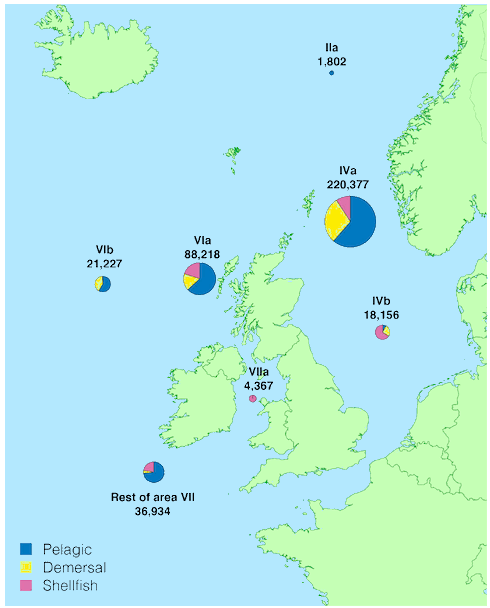
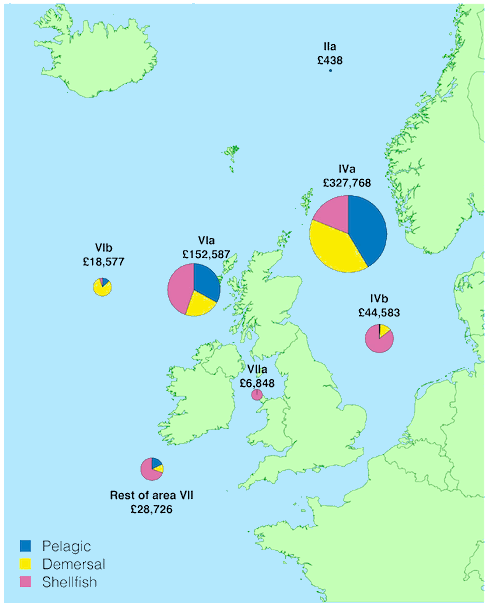
3.4. All landings into Scotland
In 2019, 300 thousand tonnes of sea fish and shellfish with a value of £523 million were landed into Scotland. This represents a 14 per cent decrease in tonnage and a two per cent decrease in real terms value from 2018. Landings of demersal species accounted for 45 per cent, pelagic species 38 per cent and shellfish species 17 per cent of the total tonnage landed into Scotland. By value, almost half (48 per cent) of landings into Scotland were demersal species, 20 per cent were pelagic and 33 per cent were shellfish species[6]. The differences in shares by tonnage and value reflect the differences in average prices per tonne (for landings by Scottish vessels) across the species types: shellfish sell at relatively higher average prices per tonne, whilst pelagic species receive the lowest average prices per tonne (Table 23).
Figure 6 and 7 show landings by all vessels by species type into the eighteen Scottish port districts (also in Table 29). Landings into the south-west coast and south-east coast were dominated by shellfish, while landings into the north-west coast were mostly demersal and the north-east coast were mostly pelagic landings. The top three districts in Scotland by total tonnage landed were Peterhead (east coast), Shetland (north) and Fraserburgh (east coast). Peterhead is the single largest fishing port in the UK by tonnage and value of landings.
Combined, the top three districts for tonnage accounted for 73 per cent of total weight landed and 59 per cent of value of all landings into Scotland. Peterhead had 147 thousand tonnes landed in 2019 with a value of £184 million. This represents a 14 per cent decrease in tonnage and a two per cent decrease in real terms value from 2018. By tonnage, just under three-fifths (57 per cent) of the landings into Peterhead comprised pelagic species and these accounted for almost two-fifths (39 per cent) of the landings value into the district. In contrast, 39 per cent of the tonnage landed into Peterhead was demersal species that accounted for 51 per cent of the value.
Landings into Shetland totalled 50 thousand tonnes (down 26 per cent from 2018) and were valued at £81 million (down nine per cent). As with Peterhead, the majority of landings into Shetland by tonnage were of pelagic species, which represented 48 per cent of the total tonnage landed and 28 per cent of the total value of landings. Demersal species accounted for 47 per cent of the tonnage and almost two thirds (63 per cent) of the value landed into Shetland.
Landings into Fraserburgh totalled 21 thousand tonnes worth £46 million. The largest landings were Shellfish species, which represented over two-fifths (41 per cent) of the tonnage landed and 60 per cent of the total value of landings. Demersal species accounted for 33 per cent of the tonnage and a quarter (25 per cent) of the value landed into Fraserburgh, with pelagic species making up 26 per cent of the tonnage and 15 per cent of the value.
The largest percentage fall in tonnage landed was into Shetland (26 per cent fall) due to lower landings of mackerel and herring into the district compared to 2018. The largest percentage rise in tonnage was into Mallaig (up 49 per cent) due to increased landings of sprats. This is following the absence of any sprat landings into Mallaig in 2018, due to none appearing in the Minch area.
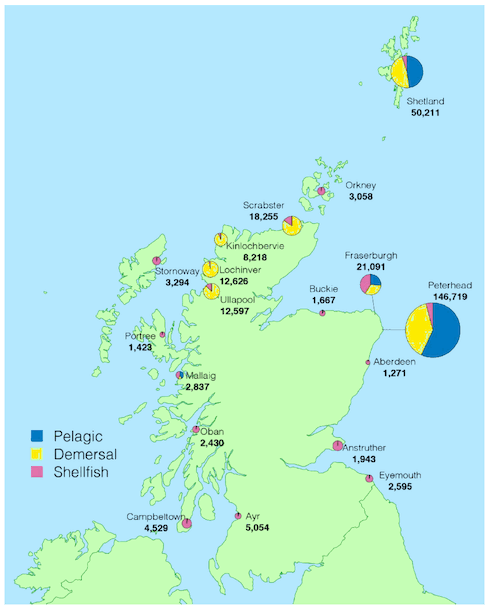
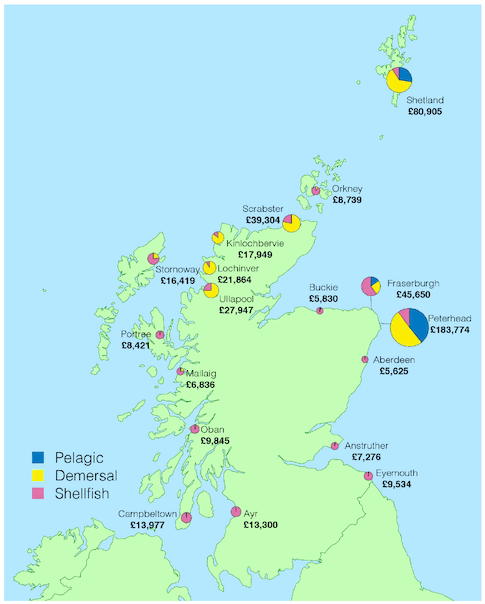
3.5. Total Allowable Catches quota and uptake
Total Allowable Catches (TAC) are limits set at annual international negotiations for individual fish stocks and represent the maximum of each fish stock that can be caught. Some stocks are managed and fished only by European Union (EU) member states. The TACs for these stocks are set by the European Commission through internal negotiations between EU member states with an interest and based on independent scientific advice from ICES. Other stocks are managed and shared with non-EU states and TACs for these are set at separate negotiations with the ‘Coastal States’: Norway, Iceland, the Faroe Islands and Russia. The EU TAC is shared among EU member states based on a number of factors, including each member state’s past catch record. The amounts corresponding to this share, known as quotas, are shown at the UK and at the Scottish Producers Organisations’ (POs) level in Table 33. Uptake of key commercial quota stocks by all Scottish vessels by tonnage and value landed are presented in Table 34.
Chart 9 compares the quota uptake of key quota stocks (with landings by Scottish vessels in excess of £20 million) for Scottish POs in the North Sea and West Coast, in 2019. In general, Scottish POs had high quota uptake in 2019 for key demersal and pelagic species. Mackerel and herring stocks in both the West of Scotland and the North Sea exceeded quota.[7] West of Scotland cod has a nil quota and is managed as a bycatch.
For demersal stocks, uptake in the North Sea was generally high with cod quota uptake at 90% and haddock at 93%. Uptake of plaice, megrim and sole was lower (35 – 59%). In the West Coast, demersal uptake was slightly more varied for each species than the North Sea. Of the three haddock stocks, all were above 75 per cent uptake. Monkfish uptake reached 83 per cent in the West Coast but was low in the North Sea at 45 per cent.
Pelagic species have consistently high quota uptake for both the West Coast and North Sea. Mackerel quota uptake was 107 per cent for both the West Coast and the North Sea. This is five percentage points up on 2018 for the West Coast and eight percentage points up for the North Sea. For herring, West Coast uptake was at 108 per cent and North Sea uptake was 102 per cent.
The only shellfish species subject to quota is Nephrops. In 2019, Scottish PO quota uptake for North Sea Nephrops was 97 per cent and for West Coast Nephrops it was 60 per cent. This is 45 percentage points up compared to 2018 for the North Sea and 11 percentage points down for the West Coast.
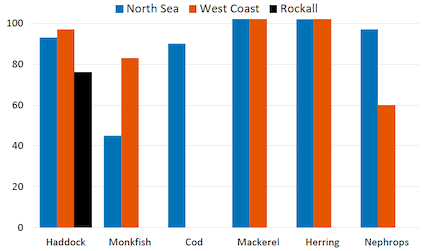
Contact
Email: fisheriesstatistics@gov.scot
There is a problem
Thanks for your feedback